Diving into the world of Patek Philippe means venturing into the most refined and prestigious offerings of watchmaking. This name resonates like a promise of excellence that spans generations, far beyond a simple timepiece.
If there is one area where investment meets passion, it is high-end watchmaking. And at the pinnacle of this sits Patek Philippe, an independent, family-owned Genevan manufacture for over a century, whose creations have become true safe havens for discerning collectors.
Through this article, I offer you an immersion into this exceptional watchmaking heritage to understand why and how Patek Philippe watches stand out as tangible assets appreciated as much for their timeless aesthetics as for their potential for financial appreciation.
From the legendary Nautilus to the accomplished classicism of a Calatrava, through the astronomical complications that defy mechanical understanding, we will explore the flagship models, their market positioning, judicious acquisition strategies, and the long-term prospects of these masterpieces which, according to the house’s adage, you never really own, but merely look after for the next generation.
Sommaire
Historical Context and Patek Philippe Heritage
Founded in 1839, Patek Philippe has established itself over time as the world’s most prestigious watch manufacturer. It is one of the last independent, family-owned houses, allowing it to preserve a philosophy focused on longevity and transmission. “You never actually own a Patek Philippe. You merely look after it for the next generation” – this iconic brand slogan, hammered home since 1996 in the Generations advertising campaign, perfectly illustrates the patrimonial dimension attached to these timepieces. Thus, acquiring a Patek Philippe is not just a personal pleasure, it is also an intergenerational investment embedded in a historical continuum.
Let’s recall Patek Philippe’s rich heritage: the Genevan house produced grand complication pocket watches in the 19th century, some of which now fetch record prices at auction (e.g., the famous Graves Supercomplication pocket watch from 1933 sold for ~$24 million in 2014). Patek created the first perpetual calendar wristwatch in 1925, and its vintage perpetual calendar chronographs (ref. 1518, 2499…) are among the most highly valued pieces in the world. This centuries-old expertise is found in every modern watch from the brand.

From 1932, the Stern family took the reins of Patek Philippe and launched the Calatrava ref. 96 that year, a three-hand dress watch model with a clean Bauhaus design that would become the quintessence of timeless elegance. Nicknamed “the banker’s watch,” the Calatrava established Patek’s style codes: finesse, sobriety, and extreme finishing quality.
Over the decades, Patek has ceaselessly innovated while building on its past: the house notably introduced the first Annual Calendar complication in 1996 (ref. 5035), a patented invention that democratized the full calendar requiring only one adjustment per year.
This articulation between tradition and innovation largely contributes to the valuation of Patek Philippe watches on the collector’s market. Patek’s annual production is around 60,000 to 70,000 pieces, an extremely limited volume on a global scale. This modest figure, combined with constantly growing demand, fuels the desirability and rarity of the models, particularly for the highly prized steel references. It was in this context that the Nautilus was born in 1976, the brand’s first steel sports watch, which would open a new chapter in Patek Philippe’s history.
Technical Innovations and Unparalleled Know-How
If Patek Philippe enjoys an unparalleled aura today, it is thanks to its technical know-how and constant innovations throughout its history. As early as 1845, Jean-Adrien Philippe (co-founder of the house) invented the keyless winding crown, a major advance that would be adopted by the entire watchmaking industry. In the 20th century, Patek distinguished itself by creating watches with extreme complications (split-seconds chronographs, perpetual calendars, minute repeaters, tourbillons) surpassing what was done elsewhere. The famous Supercomplication watch commissioned by Henry Graves in 1933 (24 complications) was long the most complicated watch in the world.
Patek Philippe has also introduced novel technical concepts on more mainstream watches. For example, the Annual Calendar – a complication that automatically recognizes months with 30 and 31 days, requiring only one correction per year at the end of February – is a Patek patented invention from 1996. The first model, ref. 5035, won the innovation prize at the Grand Prix d’Horlogerie de Genève. This practical complication was later featured in the highly appreciated ref. 5146 (caliber 324 S IRM QA LU) offering day/month display by hands and moon phases. Patek’s technical rigor is also seen in the Geneva Seal certification and later the Patek Philippe Seal applied from 2009 to its movements, guaranteeing precision tolerances of around -3/+2 seconds per day – an almost chronometric level.

Another area of innovation is the optimization of reliability and finishing. Patek Philippe introduced the Gyromax balance spring and more recently the silicon Spiromax balance spring, improving the chronometric performance of its calibers. The quality of in-house manufacturing, from the movement component to the case, largely explains the price stability of these watches over the long term. Every detail is cared for: perfectly adjusted integrated bracelets, folding clasps adorned with the Calatrava Cross, guilloché or hand-enameled dials on certain models… This level of technical and aesthetic perfection gives Patek watches extraordinary longevity, both mechanically and stylistically. Thus, investing in a Patek means betting on a piece whose very design aims to defy time.

Iconic Models with High Collector Value
The Patek Philippe catalog is full of legendary models, but certain iconic collections capture the attention of investors due to their high heritage value and market performance. Among them, five particularly sought-after families stand out:
Nautilus 5711/5712: The sporty chic turned speculative object


Introduced in 1976, the Nautilus revolutionized luxury watchmaking by daring to use stainless steel for a high-end watch – “One of the world’s costliest watches is made of steel,” boldly proclaimed the advertising of the time. This watch designed by the legendary Gérald Genta is distinguished by its rounded octagonal “porthole” case and integrated bracelet. Long appreciated by a circle of insiders, the value of the Nautilus ref. 5711/1A (three-hand date version launched in 2006) exploded during the 2010s. Demand became so high that waiting lists at boutiques reached several years, and the grey market ignited.

Thus, a new Nautilus 5711 (blue dial) sold for around $25,000 in 2015 traded for over $134,000 in early 2024 on the secondary market. Patek Philippe’s decision to stop production of the steel 5711 in 2021 fueled speculation: the final series with an olive green dial (ref. 5711/1A-014, produced for less than a year) soared to over $300,000. As for the extremely rare co-signed blue “Tiffany” edition, it reached $6.5 million during a charity auction in late 2021, setting a record for a modern steel watch.
The Nautilus 5712, a variant with moon phase and power reserve introduced in 2006, also enjoys enormous success. Its off-center asymmetrical dial gives it a particular charm for collectors. In 2024, a steel 5712/1A trades for around $130,000 on Chrono24, putting it in similar waters to the 5711 despite its additional complications. With Patek having confirmed the upcoming discontinuation of the 5712A in 2025, many anticipate a surge in its value on the market: future rarity is already fueling interest.
Find your Patek Philippe Nautilus 5712 on Catawiki (ongoing auctions and exclusive models)
Note that Patek has replaced the 5711 with the new Nautilus 5811/1G in white gold (41 mm). Despite a public price of around $70,000, this 5811 resells for nearly $170,000 on the market, a sign that the Nautilus fever is not subsiding. A true social phenomenon, the Nautilus has become a symbol of success and a speculative asset. Nevertheless, beyond the media hype, it remains a timepiece of great technical (caliber 26-330 SC) and aesthetic quality, whose historical legitimacy (first Patek sports watch water-resistant to 120m) supports its long-term value.

Aquanaut: The casual luxury gaining momentum
In 1997, for the 20th anniversary of the Nautilus, Patek Philippe unveiled a new sports watch: the Aquanaut. More accessible and contemporary, it is distinguished by its checkerboard pattern dial (nicknamed “grenade”) and especially by its tropical composite strap. The Aquanaut ref. 5167A (40 mm three-hand/date model launched in 2007) has established itself as a highly prized casual luxury watch among connoisseurs. For a long time, it was relatively underestimated compared to its big sister Nautilus – but recent years have seen its value rapidly catch up.

With a catalog price around €24,000 in 2024, the Aquanaut 5167A actually fetches over €50,000 on the secondary market, a premium of +100% over new. In the United States, its average price stands at around $68,000 in early 2024. This surge is explained by factors similar to the Nautilus: very limited production in steel, enthusiasm of new generations for luxury sports watches, and the phenomenon of rarity orchestrated by Patek (unofficial waiting lists also exist for the Aquanaut).
The success of the Aquanaut also lies in its hybrid positioning between sporty and dressy. The steel version on rubber 5167A can be worn just as easily on a casual weekend as with a suit, appealing to an affluent urban clientele seeking versatility. Patek has expanded the range with the Aquanaut Travel Time dual time zone (ref. 5164), the Aquanaut Chronograph (ref. 5968), and variations in gold, broadening the collection’s appeal. Proof of its rising aura, the Aquanaut recently joined the Tiffany & Co personalization program (a few highly coveted double-signed examples).
For the investor, the Aquanaut 5167A presents an interesting profile: its aesthetic remains modern even more than 15 years after its launch, and its restricted production guarantees a certain exclusivity. Its growth potential in value is considered serious by many experts, who see it as “the next Nautilus” in terms of reasonable speculation.
Calatrava 3919 (vintage): The more accessible classic elegance

In a completely different register, the Calatrava ref. 3919 embodies the Patek Philippe dress watch par excellence. Introduced in 1985 and produced for two decades, this 33.5 mm diameter Calatrava features the famous double-row guilloché “Clous de Paris” bezel, a clean white lacquered dial with painted Roman numeral indexes, and a small seconds at 6 o’clock. It is powered by the thin and reliable manual caliber 215 PS. For a long time, the 3919 was Patek Philippe’s entry-level model, which explains why it can still be found today on the pre-owned market at relatively affordable prices (around €8,000 to €12,000 depending on condition and accessories).
For the investor, the Calatrava 3919 represents an accessible entry point into the Patek universe. Although it does not offer the technical prowess of grand complications or the “hype” appeal of the Nautilus/Aquanaut, it has other assets: a timeless style that never goes out of fashion, the prestigious Patek signature on the dial, and a now discontinued production (it was replaced by the 36 mm ref. 5119 in 2006). Furthermore, its value is stable or even slightly increasing, benefiting from the general interest in vintage watches. Some collectors even consider that Calatravas from the 1980s-90s like the 3919 are “undervalued”: as an embodiment of Patek classicism, they could see their valuation increase in the future, as sports pieces reach peaks and enthusiasts return to more discretion.

In short, investing in a vintage Calatrava 3919 means betting on the safe value of the Patek Philippe dress watch. It is advisable to opt for an example in good condition, ideally a complete “full set” (with its original box and papers) to maximize value preservation. A model in yellow gold “J” with its original leather strap and Patek pin buckle will be the most sought-after combination. Admittedly, the expected financial performance is not of the same order as for a Nautilus, but the risk of depreciation is low because the demand for these sober watches remains constant among high-end watchmaking purists.
Grand Complications (ref. 5270 & Co.): Mechanical excellence above all
In the category of Grand Complications, Patek Philippe reigns supreme. Perpetual calendar chronographs, minute repeaters, and other astronomical calendars constitute the pinnacle of its current production. The current emblematic reference is the Ref. 5270, a perpetual calendar chronograph launched in 2011, heir to a prestigious lineage (1518, 2499, 3970, 5970).
Equipped with the fully manufactured caliber CH 29‑535 PS Q, the 5270 is offered in yellow gold, rose gold, white gold, or platinum, sometimes with special dials (the platinum version with salmon dial 5270P is highly prized). Although its public price is high – around $200,000 depending on the versions – the secondary market values it in these waters, without an excessive premium for the moment. Thus, one can find near mint 5270 rose gold pieces around €150,000 at the end of 2024, which can represent a good opportunity for those aiming for the long term.
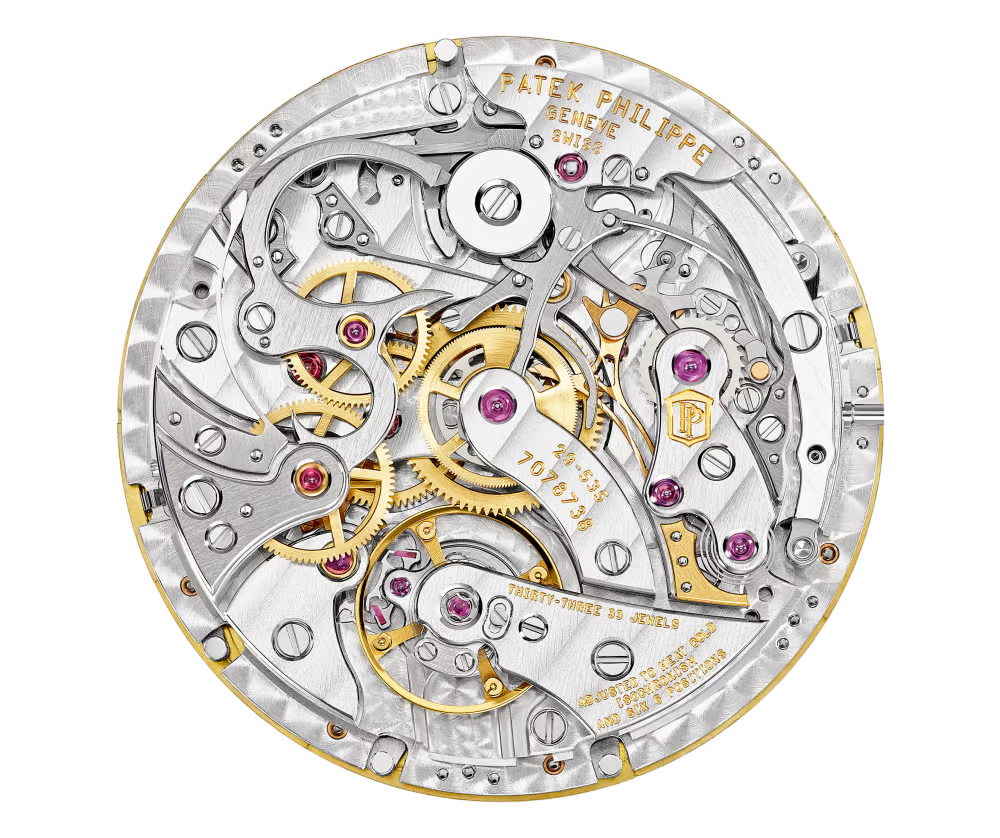
The interest in investing in a 5270 or any Patek Grand Complication lies first in the intrinsic watchmaking value of the piece. These watches are the culmination of decades of R&D and offer an extraordinary level of complication and finishing (engraving of the bridges, often complex curved case, etc.). Historically, Patek Grand Complications tend to appreciate in value over the long term, but more moderately than steel sports watches.
For example, the ref. 3970 (perpetual chronograph from the 1980s-90s) traded around €60,000 10 years ago, and easily exceeds €100,000 today on the vintage market. It is highly likely that a current 5270 will follow a comparable trajectory in 15-20 years, especially if Patek limits production or introduces a new generation (then the 5270 will in turn become a collector’s item).
For the investor, the important thing is to choose the variant well: a 5270P in platinum, produced in smaller quantities, will potentially have a higher valuation in the long run than a more common 5270G in white gold. Likewise, favoring a sought-after configuration (salmon dial, or the special “London 2015” series in yellow gold) can prove judicious. But whatever the case, placing funds in a Patek Grand Complication means opting for the top tier – one invests in a mechanical work of art whose financial valuation, while a little less speculative in the short term, is based on undeniable historical and technical importance, making it a very high-quality tangible asset in the portfolio.
Annual Calendar 5146: The modern and practical complication
Finally, the collection of Patek Annual Calendars deserves attention. Introduced in 1996, the annual calendar concept was a great success, and ref. 5146, produced since the 2000s, is its archetype. Available in yellow gold (5146J), rose gold (5146R), white gold (5146G), or even platinum (5146P), this 39 mm watch with a full calendar (day and month by apertures, date by hand, moon phase, and power reserve indicator) embodies the alliance of practicality and refinement.
Its automatic caliber 324 S IRMQA LU is derived from the legendary 315, with the bonus of the Patek Seal certification. On the market, the 5146 trades around €35,000 to €45,000 pre-owned depending on the versions, representing relative stability compared to its new price (~€40,000).
For an investor, ref. 5146 offers an interesting compromise between simple Pateks and grand complications. Its annual complication, less expensive to maintain than a perpetual calendar, attracts a clientele that uses the watch daily. As a result, demand is sustained and depreciation moderate. It is typically the kind of piece whose value will follow overall watchmaking inflation, without creating a speculative bubble but without collapsing either. It should be noted that Patek still offers the 5146 in the catalog (alongside the new Annual Calendars with chrono 5905 or travel time 5326), a sign that this model still has its place. On the secondary market, white gold versions with slate or off-white dials are slightly more sought after than yellow gold with a cream dial, as they were produced more recently and in smaller numbers. But the difference remains small.
In short, investing in an Annual Calendar 5146 means betting on continuity. It is not the watch that will increase tenfold in value in a few years, but it guarantees a solid maintenance of its value, while providing the pleasure of a useful complication and a typically Patek aesthetic (with its symmetrical double-aperture dial). For an investor-collector wishing to regularly wear their Patek without anxiety about market shocks, the 5146 constitutes a reasonable and informed choice.
Current market values (2024/2025) and rarity: An update on prices
Let’s now address the concrete financial aspect: how much are these watches worth in 2024-2025? The watch market having experienced significant fluctuations recently, it is crucial to rely on the most current data. Here is an overview of the average prices observed (in euros and dollars) and rarity trends:
- Nautilus 5711/5712 – As mentioned, the Nautilus 5711/1A (steel) was around €130,000 in early 2024, after a peak around 2021-2022 closer to €150,000. The mid-2022 correction slightly consolidated prices, but the trend remains upward over the long term. The 5712/1A is in the same range (€120-130k), proof that the additional complications do not penalize demand at all. Gold versions (5711R, 5712R…) are worth even more in absolute terms, but with a smaller premium compared to retail. As for ultra-collector Nautilus: a 5711 “Tiffany” would be worth around €3 to 4 million on the private market, and the green series 5711A-014 trades at ~€250k.
- Aquanaut 5167A – On the US market, WatchCharts indicates ~$53,000 or ~€50,000 for a 5167A in 2024. Chrono24 gives a range of $60,000 to $70,000 depending on condition. In euros, we observe around €55,000 to €60,000 for a recent full set. This is more than double the boutique price (~€24,000), which attests to the scarcity organized by Patek. Aquanaut complications (Travel Time 5164 in steel) exceed €80-90k, and the rose gold version on a gold bracelet (5168/1R) approaches €120k.
- Calatrava 3919 – On the dress watch side, pre-owned 3919s are found between €7,000 and €12,000 depending on the gold and condition. Specialized dealers often display around $10,000 (~€9,400) for a 3919J with box and papers. This segment has moved little: 10 years ago these watches were already worth ~€7,000, so we observe a modest but constant appreciation, aligned with the general increase in the price of gold and interest in vintage Patek. A Calatrava 96 from the 40s-50s, older and smaller, can be worth between €15,000 and €25,000 if in excellent condition, a sign that the 3919 still has appreciation potential (even if it is less rare).
- Grand Complications 5270 – In boutique, a 5270G or J is around €190k (excl. VAT). On the secondary market, near new pieces are seen around €150k, some mounted on an integrated gold bracelet (ref. 5270/1R) reaching ~$170k. The more exclusive platinum version 5270P sells for closer to $180-200k. It is interesting to note that these amounts are relatively close to new: the clientele for these watches being restricted and well-informed, speculation is limited. In the long term, slow appreciation can be expected (for example, WatchCharts tracks a slight increase of +5% per year on average over the last 5 years for the 5270).
- Annual Calendar 5146 – Second-hand, a 5146J or G in good condition trades around €35,000 (i.e., -10 to -15% of the new price). The R (rose gold) versions sell for a little more, ~€38k, and the rare 5146P in platinum can reach €45-50k. The rarity dynamic on this model is moderate: it is regularly found at auctions or dealers, a sign that supply exists. However, each year new generations of buyers discover the interest of this accessible complication, maintaining demand. It is therefore likely that these prices will hold, or even follow inflation as mentioned. The recent release of new Patek references (like the 5205 annual calendar with moon phases) has not really diminished the appeal of the 5146, which remains a classic.
In summary, the current Patek Philippe market oscillates between two poles: steel sports pieces with very high and volatile valuations, and classic gold pieces with more stable valuations. A wise investor will need to take this into account to balance their “watch portfolio” based on their risk appetite and investment horizon. It is recommended to follow specific indices (e.g., the WatchCharts or Chrono24 index) that measure the price evolution for each model, in order to detect trends (consolidation, sustained rise, etc.) and adjust their strategy accordingly.
Purchase Strategy: Primary vs. Secondary, Full Set, Diligence, and Conservation
Faced with these findings, how can one optimize their Patek Philippe investment? Here are some concrete tips for purchasing and managing these valuable watches:
Acquisition Channels: Official Dealer or Secondary Market?
Ideally, buying new at a boutique is the dream scenario – you pay the list price, significantly lower than the market for models like the Nautilus or Aquanaut. But this access is almost impossible without a solid purchase history with the dealer. For most investors, one must turn to the secondary market (specialized sellers, auction houses, exchange platforms). This means paying the rarity premium, but it is often the only way to obtain the coveted watch without waiting 10 years. Purchases on the secondary market must be made from trusted sellers, with verification of authenticity (serial numbers, Patek archive extract if necessary) and history (provenance, invoices).
“Full Set” and Condition: Determining Criteria
On the collector’s market, the presence of the original box and papers (certificate) – what is called a “full set” – can add 10 to 20% value. This proves that the watch does not have a dubious origin and has been cherished. For a recent Patek, a full set is almost a prerequisite for a good investment. Furthermore, the condition of conservation greatly influences value: an unpolished or lightly polished watch, with its case angles well-defined, will be preferred by discerning collectors. Sometimes a small ding or micro-scratch from use is better than excessive polishing that alters the proportions. Keeping the watch in its original condition, even having mechanical servicing done without aesthetic retouching, is generally the right approach.
Patience and Vigilance: Seizing Opportunities
Investing in a Patek Philippe requires patience – patience if attempting the official route (accumulating less demanded purchases to hope for “the grail” via the dealer), and patience on the pre-owned market to watch for a good deal. It can happen that, during a market correction phase, certain pieces return to more reasonable levels.
For example, in mid-2022, Nautilus 5711s were seen temporarily dropping below €100k before climbing back up. An actively vigilant investor could have seized the opportunity. It is therefore recommended to regularly follow specialized auctions and marketplaces: occasional opportunities (collection put up for sale, a seller’s need for liquidity…) can allow acquiring a Patek at a price below market.
Maintenance and Insurance: Protecting Your Watchmaking Heritage
Once the watch is acquired, it should be protected properly. This involves periodic maintenance at Patek Philippe or an authorized watchmaker (generally every 5 to 7 years for an automatic caliber, anticipating that Patek charges several thousand euros for a complete overhaul of a grand complication). Keeping service receipts also adds value (proof of seriousness). Furthermore, insuring your watch is essential: a specific valuables insurance will cover against theft or damage. For very expensive pieces, some opt for storage in a secure safe when not worn, although this diminishes the pleasure of ownership. Everyone will adapt this to their context, the essential thing is to mitigate the risks of financial loss.
Resale Perspective: Timing and Platforms
Finally, think about your resale horizon from the time of purchase. If you are aiming for the very long term (more than 10 years), favor “timeless” models or those with limited production (which will not suffer from a fashion downturn). If you plan to resell within 5 years, closely monitor the market situation: it may be wise to sell during a peak in demand (e.g., just after an announcement of a model’s discontinuation).
For resale, favor recognized channels (auctions at Christie’s, Phillips, Sotheby’s, or reputable brokerage platforms) to reach the wide audience of international collectors and maximize the price obtained. The transaction cost (commission) will be higher than a private sale, but the security and visibility are often far superior.
Conclusion: An investment of both passion and reason
In conclusion, investing in a Patek Philippe can prove to be an adventure as financially enriching as it is intellectually stimulating. These exceptional watches indeed combine all the advantages of a high-end alternative investment: orchestrated rarity, growing global demand, timeless brand prestige, and the production of technical masterpieces whose utilitarian value (telling time with panache) transcends trends. Of course, like any investment, it carries its share of uncertainties; but history has shown that Patek Philippe creations tend to appreciate or at least preserve their purchasing power over the long term, supported by a highly structured collector market.
The watchmaking Grail that is a Patek Philippe Nautilus, Aquanaut, Calatrava, or Grand Complication is not just a static trophy in a safe: it is also a living object that can be admired, worn, passed down. This dual dimension of “passion and reason” is what makes watch investment unique. Like the “Sartorial Sleuth” style, one could say that investing in a Patek is a bit like “wearing your strategy on your wrist,” blending personal aesthetic pleasure with a thoughtful heritage approach.
Ultimately, whether you opt for the coveted sportiness of a Nautilus or the gentle elegance of a vintage Calatrava, the important thing is to inform yourself, buy prudently, and savor this union of high watchmaking and high finance. Because if the value of your Patek Philippe climbs, all the better for you; but whatever happens, you will have had the privilege of being its guardian, even if only for a time, before passing it on – perhaps with profit – to the next generation. And that is the true spirit of Patek Philippe.

2 réflexions au sujet de “Investing in a Patek Philippe in 2025: Complete Guide and Undervalued Models”